1. Creation of wetting patterns based on omniphobic materials
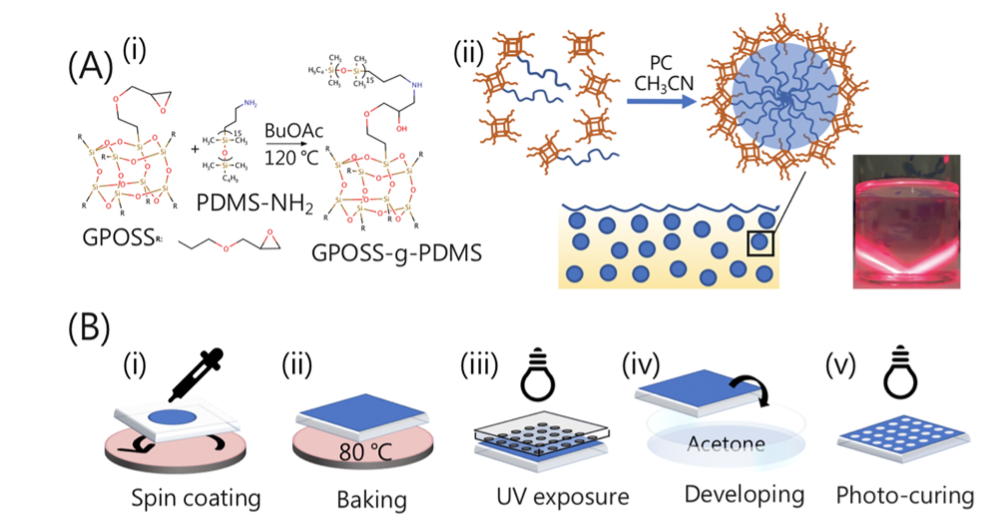
Wetting patterns preparation scheme. (A) - Scheme of micellar solution synthesis; (B) - Application of omniphobic solution followed by photolithography
The challenges posed by the current pace of scientific and medical development require new approaches to obtaining and analyzing data. Classical methods of experimentation do not allow to achieve the required performance. To solve this problem, methods of miniaturization and scaling of experiments are used. This project aims to implement such an approach using the wettability properties of functional materials. The key property investigated in the project is omniphobicity. In practice, both water and organic solvents can slip off omniphobic surfaces without leaving traces, while carrying away various contaminants. The unique wettability properties give omniphobic materials a wide range of applications from oil extraction to working with microorganisms.
This project is working on both the development of new omniphobic materials and their applications. The application part of the project is to structure omniphobic materials to create new high-throughput screening platforms that will be used to perform organic synthesis experiments in microvolumes and to study the biological activity of small molecules.
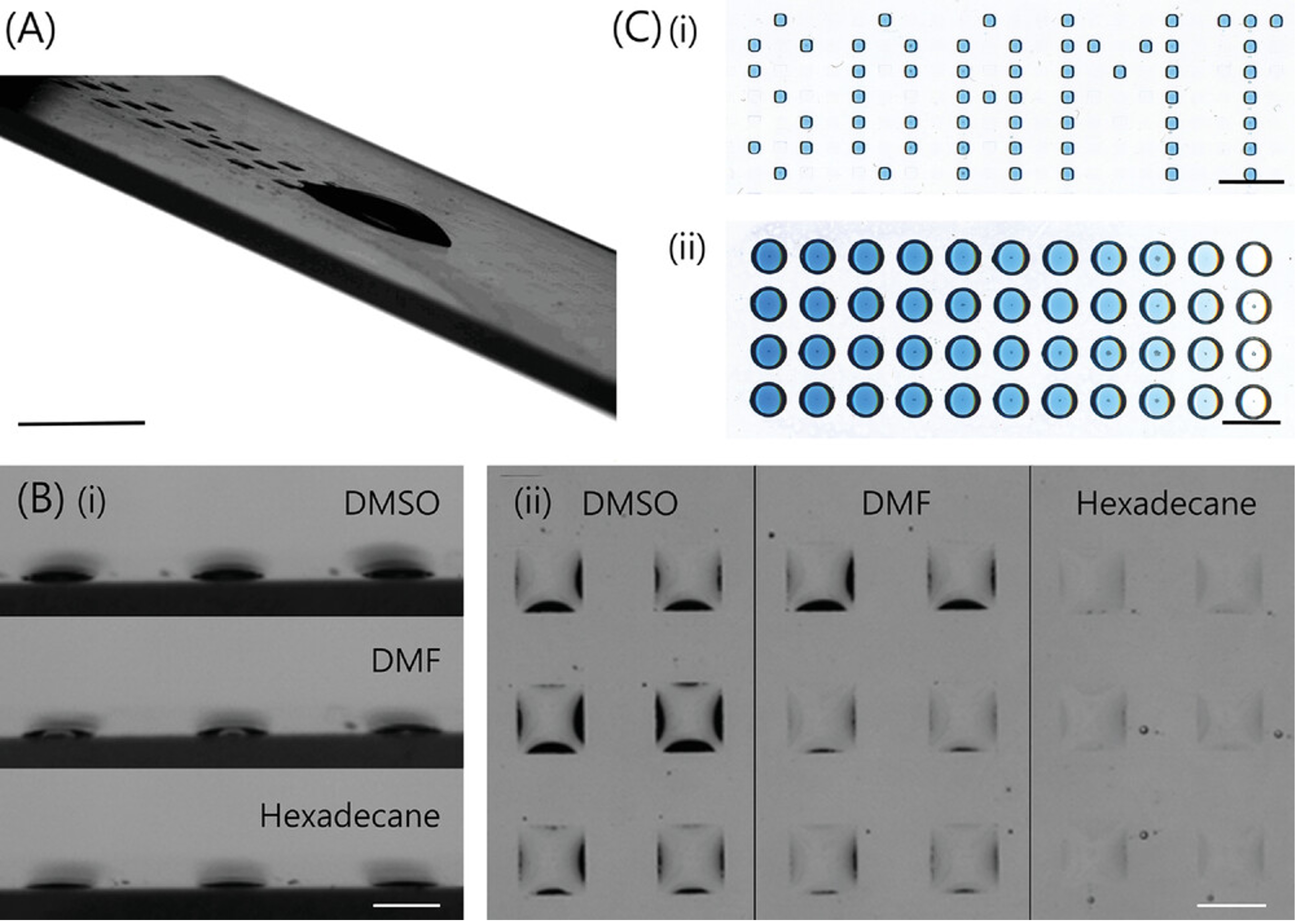
Application of liquids with different surface tension on omniphobic GPOSS-PDMS pattern. (A) - Application of hexadecane; (B) - application of DMSO, DMF and hexadecane; (C) - example of patterning on chip using iDOT MINI liquid dispenser.
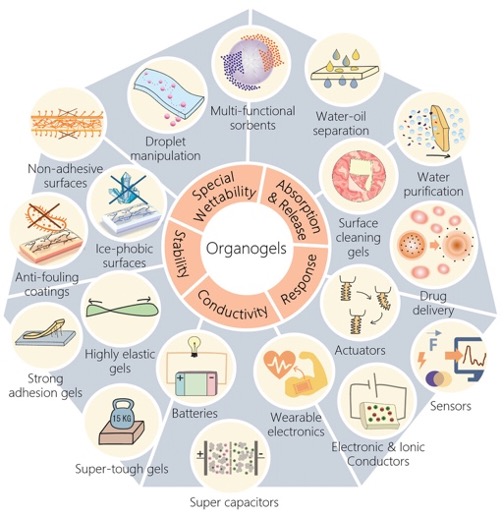
Fields of arganogels applications
In this project we are developing the first positive photoresist based on organogels. Gels are a special kind of soft materials that combine the properties of liquid and solid. This project studies the photodegradation ability of organogels. In the research such methods as IR, UV spectroscopy, as well as various methods of microscopy - electron and optical are used. This work was supported by the RNF grant 22-73-00111
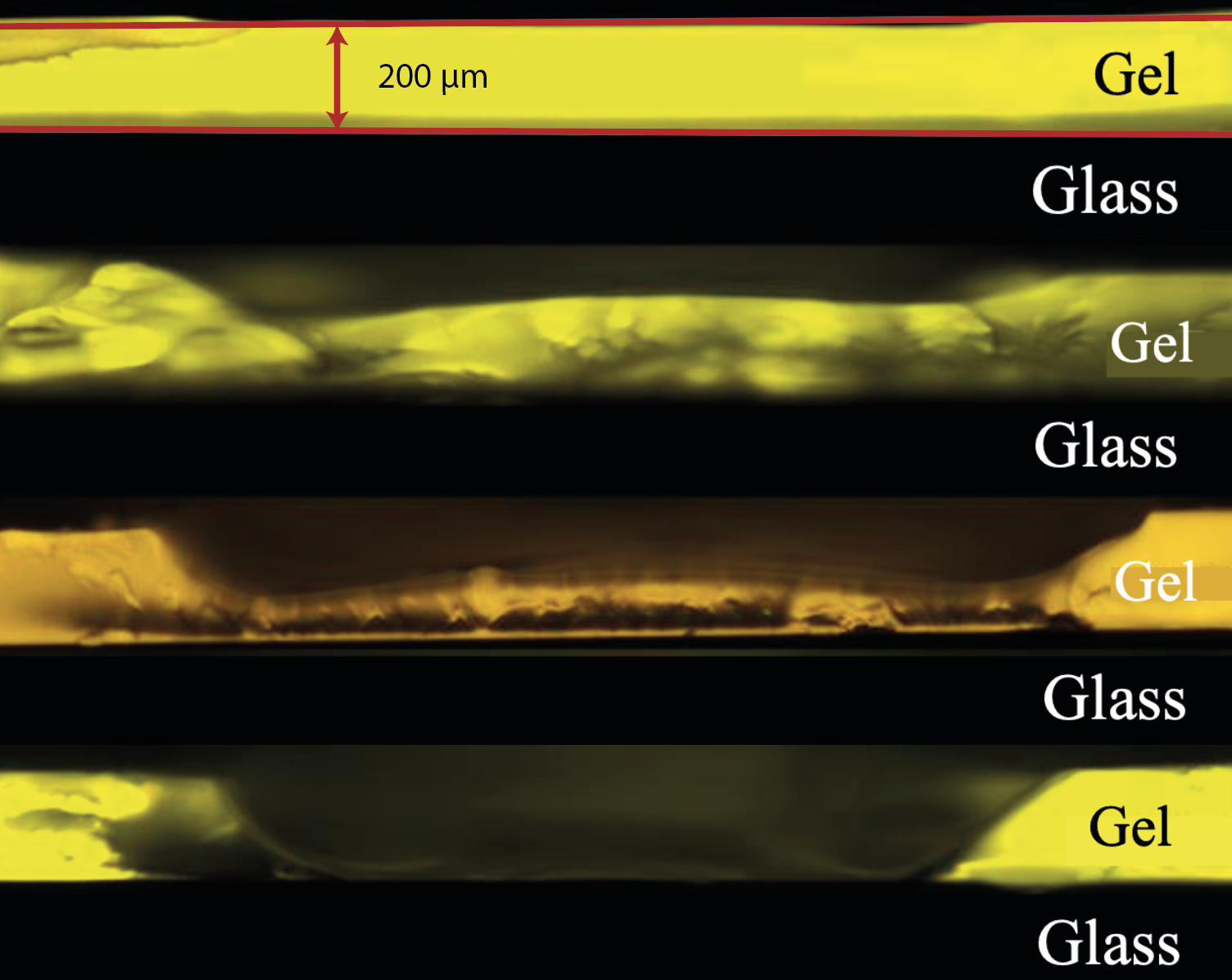
Degradation of organogel by UV treatment for 0, 10, 20 and 30 minutes
3. Obtaining fibrin clots on omniphobic platforms for the development of a screening test system for thrombosis and fibrinolysis disorders
Cardiovascular diseases (CVD) such as myocardial infarction and ischemic stroke remain one of the main causes of high mortality and disability of the population of the country and the world, so their treatment is relevant. Often these diseases occur as a result of thrombosis, in which a thrombus blocks a blood vessel, disrupting the blood supply to areas of organs. One of the approaches in the treatment of myocardial infarction and ischemic stroke is thrombolysis - controlled destruction of blood clots under the influence of drugs.
However, a significant number of patients have hyperglycemia, which increases the risk of complications and complicates therapy. Molecular mechanisms of hyperglycemia influence nowadays remain poorly studied, despite the large number of cases of CVD on the background of increased blood glucose levels.
The aim of this project is to study the mechanisms of hyperglycemia influence on the course and outcome of cardiovascular diseases, in particular on resistance to thrombolysis for the development of new diagnostic and therapeutic approaches.
The study will involve modeling thrombolysis under hyperglycemia conditions, establishing the structure of active centers of proteins involved in this process for use in the development of approaches to diagnostics, treatment and prediction of outcomes of therapy of cardiovascular diseases for patients with hyperglycemia

Modeling of thrombolysis under thrombolytic action on an omniphobic pattern. Arrows indicate the front of thrombus dissolution
4. Development of high-throughput methods for 2D and 3D cell cultures cultivation on a platform with controlled wettability
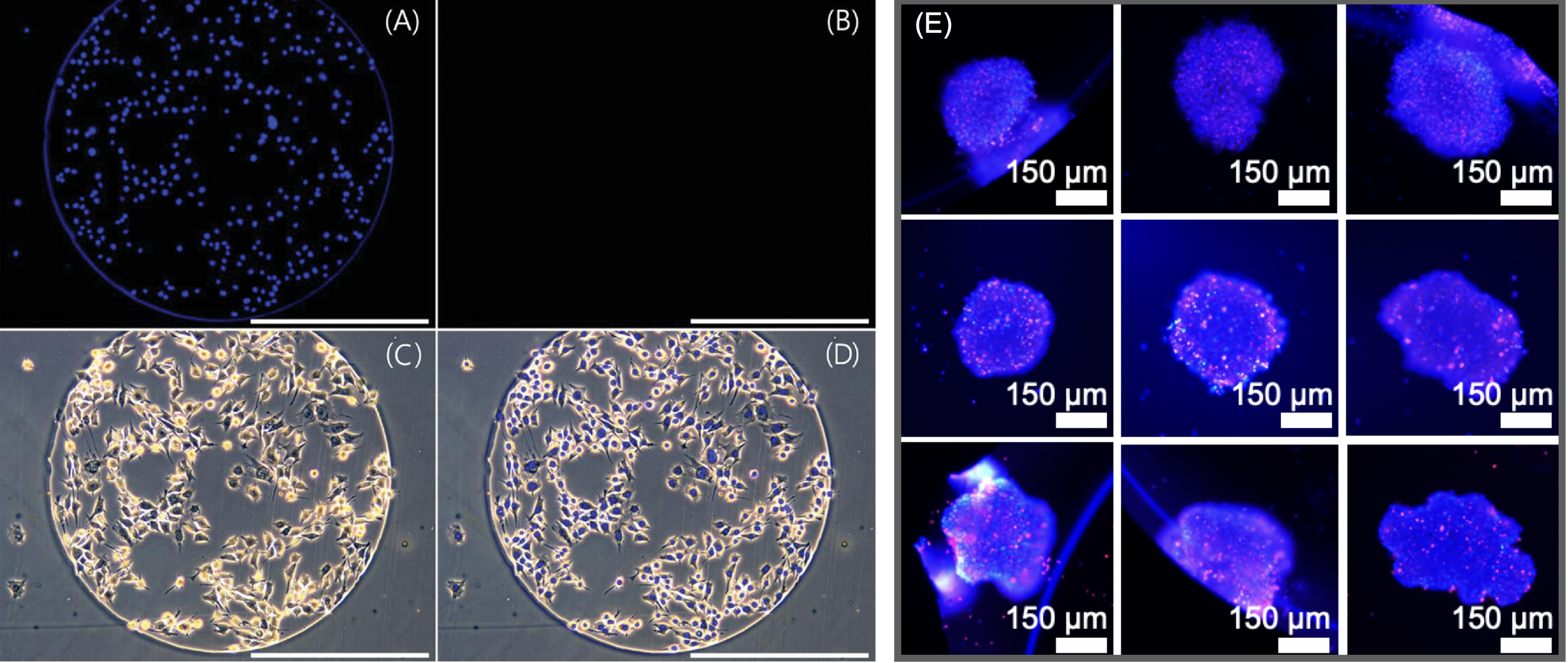
Cell culture on omniphobic pattern. (A)-(D) - C2C12 monolayer grown on the pattern; (E) - HPF spheroids
The development of new drug molecules is impossible without testing their properties on cell cultures, so improving the performance and efficiency of test systems is an important challenge in biomedical research.
In our laboratory, we are conducting research in which we aim to miniaturize and automate standard cytotoxic tests, such as the MTT test, for example. For this purpose, we utilize specially designed omniphobic chips with omniphilic spots in which cells are cultured in both monolayer and 3D volumes. By reducing the well size to 3 mm and placing cells in a droplet, we can increase the number of experimental spots by 8-fold compared to a standard 96-well plate.
This research will accelerate drug testing by enabling more than a hundred in vitro tests to be performed on the chip in a single experiment.
5. Development of bacterial cellulose scaffolds for biomedical applications

(A) - Bacterial cellulose grown on omniphobic pattern; (B) - Structure of bacterial cellulose grown under normal conditions; (C) - Structure of bacterial cellulose grown under magnetic field conditions. Pictures (B) and (C) were obtained using a scanning electron microscope
According to statistical data, the most frequent cause of death in the world is cardiovascular diseases. To solve this problem, it is necessary to create biocompatible scaffolds that will allow to partially or completely replace the affected tissue areas. The idea of this project is to use bacterial cellulose (BC) as a scaffold to grow myocardial tissue, captured from the patient's stem cells, and suitable for further transplantation. BC is already used in medicine as a base for composite wound coverings and is a promising material for reconstructive surgery, cell and tissue engineering due to its unique properties.
Our laboratory is investigating ways to influence the microstructure of bacterial cellulose films synthesized by bacteria by changing the cultivation conditions. Research is also underway to modify BC biofilms with electrically conductive polymers to provide conductivity at a level consistent with heart tissue.
This research aims to create scaffolds that mimic native body tissues. The most important part of this project is the cultivation of cells, in particular cardiomyocytes, on the surface and in the thickness of the obtained matrices, for which it is also necessary to control the microstructure and mechanical properties of BC biofilms.
6. Establishment of correlation between micro- and macro-parameters of bacterial cellulose for biomedical materials
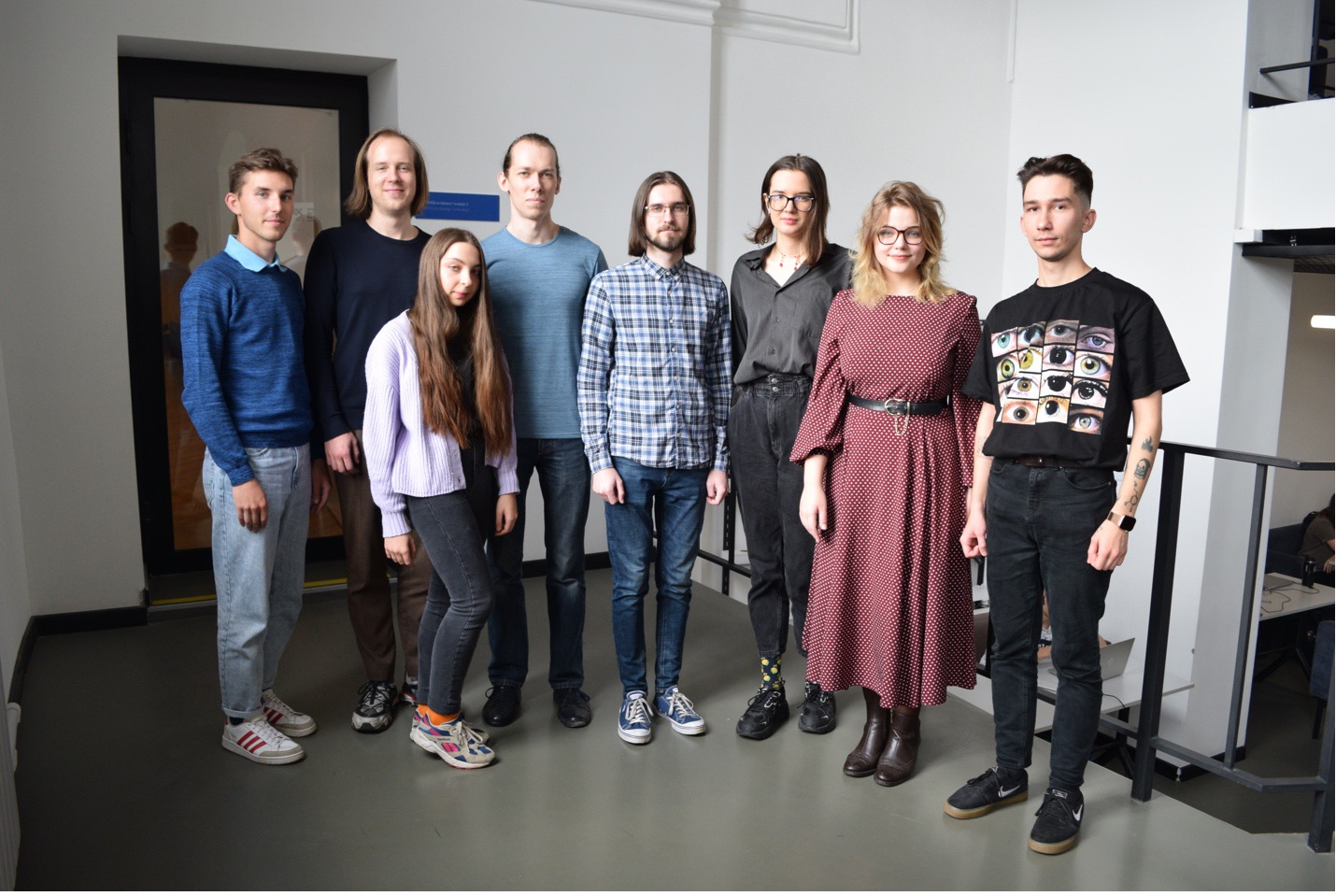
One of the projects of the laboratory "Bioactive Materials for Tissue Engineering" is the study of the influence of bacterial cellulose synthesis conditions on its microparameters for a wide range of applications on the basis of AGNI university with co-financing from PJSC TATNEFT. Artificial intelligence is used to predict the properties of bacterial cellulose from the conditions of its cultivation, and to generate conditions for obtaining cellulose with specified parameters. After such physical properties of synthesized samples as fibril size, swelling ability and mechanical strength are studied, bacterial cellulose powder is examined for hemostatic and thrombotic activity.